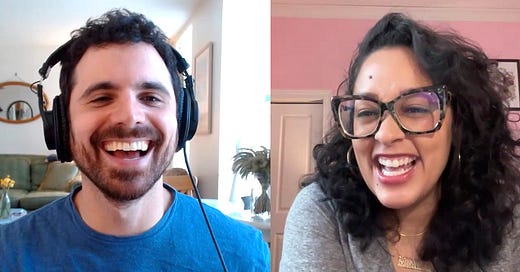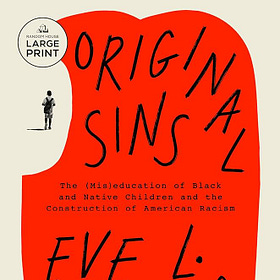The Trump administration is poised to try and close the Department of Education. For Professor Eve L. Ewing, “it’s an open question” whether we should abolish schools altogether, albeit for very different reasons.
Professor
is a writer, scholar, and cultural organizer. She’s an associate professor in the Department of Race, Diaspora, and Indigeneity at the University of Chicago. Her work has been published in The New Yorker, The Atlantic, The New York Times, and many other outlets. Most recently, she’s the author of Original Sins: The (Mis)education of Black and Native Children and the Construction of American Racism.Professor Ewing argues that the pillars of American racism are reinforced in schools. She’s conflicted about whether we need to rebuild schools from the ground up, but there’s no doubt we need to reclaim “ancient ways of knowing.” A condensed transcript of our conversation, edited for clarity, is below. You can also listen to the podcast version:
There's an Argument for Abolishing Schools
Listen now (57 mins!) | Podcast version of my conversation with Professor Ewing
Ben: To name them up top, what are our “original sins”?
ELE: When I say original sins, I'm referring to the system of chattel slavery that kidnapped people from Africa, brought them here, and rendered them as property. The genocide of Indigenous peoples is the other sin.
It's far more common for people to refer to enslavement as America's original sin, but I believe both are important to discuss together. For years, in my syllabus, I titled these sections "Original Sins: Week 1" and "Original Sins: Week 2." Eventually, I wanted to cohere them into a book, and here we are.
Ben: “Original Sins: Week 10,000.”
ELE: Ha, yeah, five years later.
In the book, I argue that there are three pillars of American racism that act on Black and Native people in schools, though not always in the same ways.
The first is the gospel of intellectual inferiority—the idea that Black and Native people are inherently less intelligent.
Ben: "For white supremacy to thrive,” you write, “the complete eradication of Black and Native ways of knowing is required.”
ELE: Yes, that synthesizes a lot.
I was a public middle school teacher in Chicago, my hometown. My scholarship starts there—and even before then, as a public school student in Chicago.
Often, well-meaning educators internalize the idea that their students’ homes are bad and inadequate—that students bring nothing of value to school. For both Black and Native students, there’s long been this idea of what scholar Erica R. Meiners refers to as "white lady bountiful": a quintessentially good white lady educator has to go in and save them.
You've had some great scholars of prison, policing, and abolition on Skipped History. Many of those scholars would say that we live in a carceral culture, where punishment is our first recourse for any transgression. I think the conversation about intelligence—who is intelligent, what is intelligence—has similarly unquestioned assumptions.
Ben: On the topic of unquestioned assumptions, Columbus comes up throughout the book. You demonstrate how so much classroom literature still couches debates over Columbus as "let’s learn both sides."
ELE: What I find maybe most bizarre is that so much of the curricular content on Columbus is for very young children—pre-K, kindergarten, first grade, second grade. We've made this collective decision that it’s important for little kids to know who Columbus is. You see worksheets like "Columbus is going on a trip. What would you pack?"
When teachers present this content to young children, the pushback is, "Well, you’re not telling them the true story." The retort is, "Well, it’s inappropriate to talk about mass murder with little kids."
Now, there are other human rights atrocities where we've figured out age-appropriate ways to introduce them. Maybe you read Number the Stars when you're nine or ten, then learn about the Holocaust again in eighth or ninth grade. You circle back in age-appropriate ways. There are also topics we decide not to talk about with five-year-olds.
Either of those options is available. Instead, as a culture, we're like, "No, we're going to teach five-year-olds that Columbus was their friend." I find that exceedingly bizarre and one of the ways we normalize genocide.
Ben: You mention your own experience as a fifth grader, searching for baggies of M&Ms to imitate explorers.
ELE: We also had to do a report on a spice. I was assigned dill—which, for the record, is an herb.
Ben: And “that was it for the Age of Exploration—M&Ms, brave men, and dill,” you write. Those three items together would make for a vile yet intriguing challenge on Chopped.
ELE: Ha, gross.
In the book, I also wanted to think about what work is and what it's for. Now, people are rightfully questioning whether they want to work for companies that don’t value them, and if maybe they can live more simply.
Going back, I was fascinated to find all this archival documentation of white settlers complaining about how both Black and Native people "don’t like working enough." The complaint was that they worked just enough to feed their families and take care of themselves, and then they wanted to rest and have leisure. And that was a problem.
Ben: They didn’t want to “accumulate.”
ELE: Exactly. They didn’t understand that “God wants us to accumulate."
One quote I found was from Merrill Edwards Gates, chair of the Board of Indian Commissioners and former president of Rutgers and Amherst in the late 1800s. Gates said, "Get the Indian out of the blanket and into trousers. And trousers with a pocket in them. And with a pocket that aches to be filled with dollars."
I mention his credentials because a lot of these people, who said and did horrible things, had incredibly influential leadership positions in education. They weren’t fringe actors.
Ben: That’s a great point you raise in the book: we tend to disregard lots of old racist beliefs as pseudoscience “rather than confronting the fact that they were considered orthodox science.”
Meanwhile, you add, “We’d never call the early work of Galileo, da Vinci, or Newton pseudoscience.”
ELE: Right, even though their axioms were sometimes wrong.
Ben: From now on, I will refer to da Vinci’s Vitruvian Man as pseudoscience. How scientific can it be if you depict everyone as having four arms and legs?
ELE: Haha, yeah, I mean the proportions are off to begin with.
Ben: What are the other two pillars of racism in schools?
ELE: So we’ve discussed intellectual inferiority. The second pillar, which I’ve alluded to, is regimes of discipline and punishment—the idea that Black and Native people require a different level of bodily control. Schools, for these kids, exert control as forcefully as possible and punish them as needed.
The third is economic subjugation. In a capitalist society requiring underpaid labor, schools reinforce that Black and Native people are destined to occupy that underclass.
The economic subjugation chapter was the hardest to write.
Ben: How come?
ELE: Well, I knew I wanted to talk about wealth disparities. We've been hearing about the Black-white wealth gap for years. I think people have done a good job of starting to understand that it's not just about income. It's about the way the GI Bill did or didn't work for your family, employment discrimination, redlining—all these things add up.
But Native people are chronically underrepresented—or, to say it less passively, not included—in this kind of data. I ended up writing and learning a lot about land-grant universities.
Ben: You document how in 1862, Congress passed the Morrill Land Grant College Act, which parceled out millions of acres of Indigenous land for universities. New universities included LSU, Cornell, the University of Minnesota, and the California system.
ELE: I track which universities benefited the most financially from these land transfers (especially Cornell). I then look at how many Native people they have in their most recent graduating classes. It's abysmal.
Ben: Per your research, Native students make up less than half a percentage point of the enrollment at land-grant universities.
ELE: Not good.
Ben: You touched on abolition earlier, and you end the book by discussing abolishing schools. Where do your thoughts stand now?
ELE: I identify unequivocally as a prison and police abolitionist. Our culture of punishment has an outsized impact on young people. And to be clear, if you propose a group of community members intervening in crises without sending people to prison, that’s abolition.
From that philosophical starting point, there’s a related argument to be made about abolishing schools. At the end of the book, I quote my friend and scholar David Stovall. He wrote the essay "Are We Ready for ‘School’ Abolition?" He argues that the roots of American schooling have deep systemic problems, and to save education, we need to abolish schools.
Most of what I trace in this book supports that argument, yet I still struggle to agree. I see education, resilience, and subversion happening in schools all the time. And in a society with an eroded social safety net, schools provide basic resources and rights. They remain places where, if you are unhoused or undocumented, you can still go. During the pandemic, when schools were closing, part of the conversation was: How will some kids eat?
An honest conversation about school abolition has to account for that system. On the other hand, education isn’t just what happens in an institution—it’s a process of learning in conversation with community, nature, and history—learning in ways that long predate our education system. How can we get back to ancient ways of knowing?
It’s an open question for me. People should read the book and, if you see me on tour, tell me how you feel.






Universities built on stolen Indigenous land- who knew?